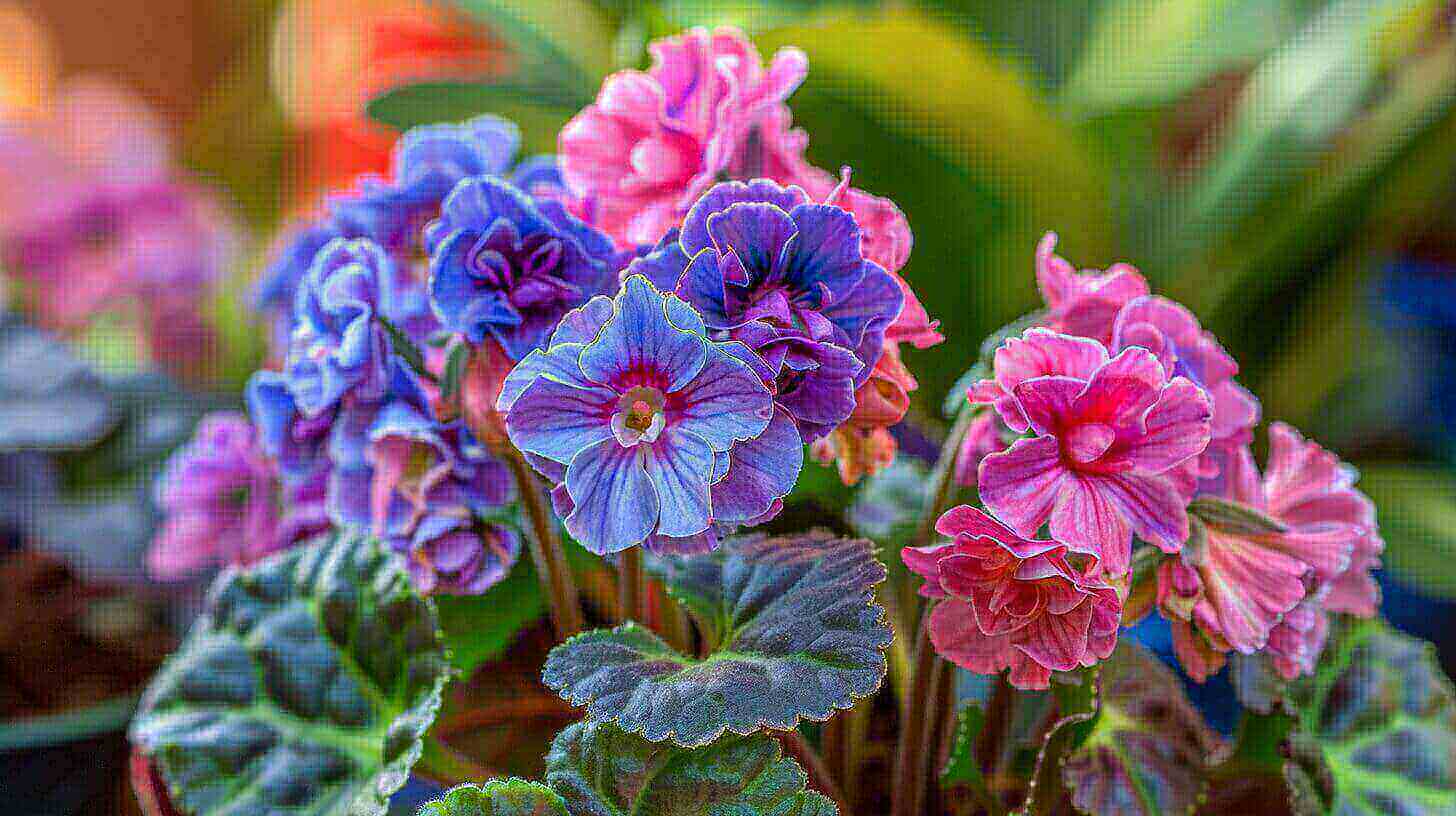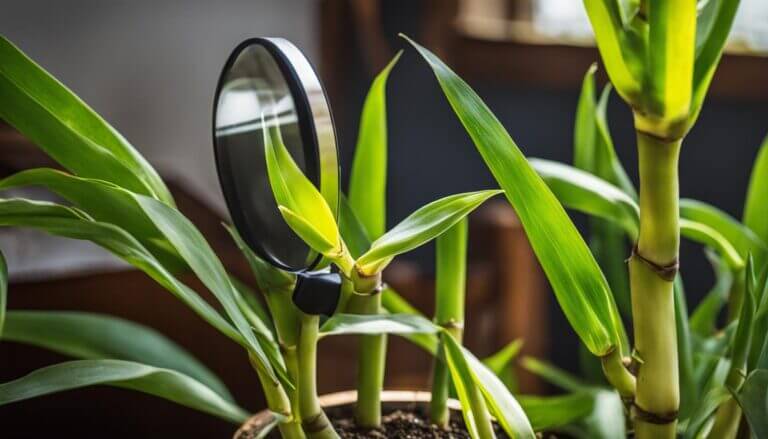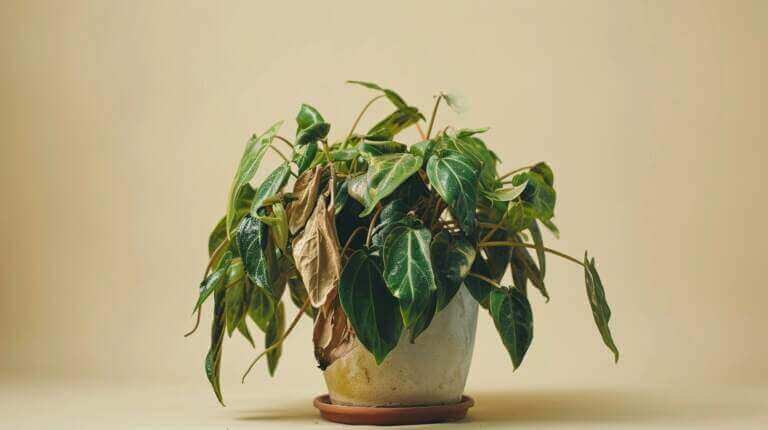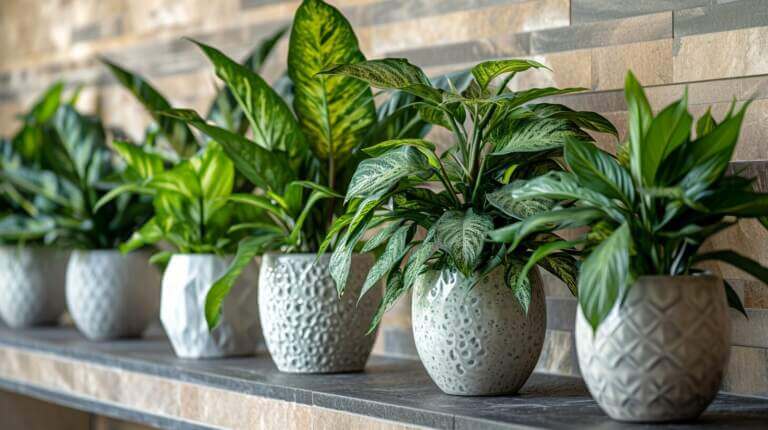Discover African Violet Hybrids and Cultivars – Enjoy Indoor Gardening
If you’re an indoor gardening enthusiast looking to add some vibrant colors and beautiful blooms to your home, African violets are the perfect houseplant. These stunning flowering plants, also known as Saintpaulia, have captured the hearts of many with their wide range of flower colors, shapes, and leaf patterns.
Originally discovered in 1892 by Baron Walter von Saint Paul in Tanzania, African violets belong to the family Gesneriaceae. Over the years, breeders have developed numerous hybrids and cultivars, expanding the options available to plant lovers. No longer limited to just violet in color, African violets now come in shades of pink, white, mauve, and even bicolor blooms. With single or double blossoms and varying sizes, there’s a perfect African violet for every indoor space.
Key Takeaways:
- African violets, also known as Saintpaulia, are popular for indoor gardening and offer a wide range of flower colors, shapes, and leaf patterns.
- Hybrids and cultivars have expanded the variety of African violets available, with options beyond the traditional violet color.
- African violets thrive in bright but indirect light and prefer a temperature of 65°F to 80°F with 80% humidity.
- Proper watering, soil mix, fertilization, and pest control are crucial for successful African violet care.
- Joining a local African violet society or seeking advice from experts can provide valuable guidance and support.
Cultivation Tips for African Violets Plant
When it comes to caring for African violets, it is important to provide them with the right conditions. These plants thrive in bright but indirect light, mimicking their natural habitat under the forest tree canopy. Artificial lighting can also be used, with two 40-watt fluorescent lights placed 8-12 inches above the plants.
African violets prefer a temperature between 65°F and 80°F with about 80% humidity, so it’s important to avoid temperature and humidity fluctuations. When it comes to watering, it is best to use room temperature water and avoid getting water on the foliage to prevent leaf spotting. The watering method can vary, with options such as using a saucer filled with water or a wicking system.
African violets prefer a light soil mix with good drainage and should be repotted annually using a mix specifically formulated for African violets. Fertilizing with a balanced liquid fertilizer and watching out for pests such as mealy bugs, aphids, and spider mites are also important aspects of African violet care.
Table: Recommended Conditions for African Violets
| Conditions | Recommendation |
|---|---|
| Light | Bright but indirect light or artificial lighting |
| Temperature | 65°F to 80°F |
| Humidity | Around 80% |
| Watering | Use room temperature water, avoid getting water on foliage |
| Soil | Light mix with good drainage |
| Repotting | Annually using a mix formulated for African violets |
| Fertilizing | Use balanced liquid fertilizer |
| Pest Control | Watch out for mealy bugs, aphids, and spider mites |
With proper care and attention, you can enjoy the beauty of African violets in your indoor garden. Remember to provide them with the right lighting, temperature, and humidity conditions. Water them carefully, using the appropriate method, and make sure to use a well-draining soil mix. Fertilize regularly and keep an eye out for pests to ensure the health and vitality of your African violets.
Exploring the Variety of African Violet Hybrids and Cultivars
When it comes to African violets, the variety of hybrids and cultivars available is truly remarkable. Gardeners and indoor plant enthusiasts have a wide range of options to choose from, with thousands of named varieties to explore. From different sizes and flower types to unique leaf patterns, African violets offer something for every taste and preference.
One of the fascinating aspects of African violets is their size diversity. These plants can range from micro-miniatures, measuring less than 3 inches across, to large varieties that stretch up to 12 to 16 inches across. With such a range, you can create a beautiful display by combining different sizes and shapes to add depth and visual interest to your indoor garden.
Not only do African violets come in various sizes, but they also exhibit a remarkable assortment of flower types and textures. You can find single blooms with a classic, elegant look, or opt for semi-double or double blooms for a fuller appearance. The petals can be frilled, ruffled, star-shaped, or bell-shaped, adding a touch of uniqueness to each variety.
Additionally, African violets showcase a stunning array of leaf patterns and textures. The leaves can be solid green or variegated with intricate patterns of green and white. The surfaces can be smooth or quilted, while the edges can range from smooth to slightly indented to very wavy. The combination of different leaf patterns and textures creates a captivating visual effect, enhancing the overall beauty of these plants.
Popular African Violet Varieties
| Variety | Description |
|---|---|
| ‘Amethyst’ | Features pale purple flowers |
| ‘Champagne Pink’ | Variegated foliage and light pink double flowers |
| ‘Crimson Ice’ | White flowers with fuchsia spots |
These are just a few examples of the incredible variety that African violets offer. Whether you’re a seasoned collector or a novice gardener, exploring the world of African violet hybrids and cultivars is sure to be an exciting journey filled with beauty and wonder.
Tips for Propagating African Violets
Propagating African violets is an exciting way to expand your collection and share these beautiful plants with others. One of the most common methods of propagation is through leaf cuttings. To propagate African violets using leaf cuttings, follow these simple steps:
- Choose a healthy leaf from the parent plant. Make sure the leaf is mature and free from any signs of disease or damage.
- Using a sterilized knife or scissors, cut the leaf from the stem, leaving a short stem attached to the leaf blade.
- Prepare a mixture of wet sand and vermiculite in a small container. Make small holes in the mixture and insert the leaf cuttings, burying the stem slightly.
- Place the container in a warm, bright area, but avoid direct sunlight. Cover the container with a plastic dome or a clear plastic bag to create a humid environment.
- Monitor the leaf cuttings regularly, ensuring that the soil mixture remains moist. After a few weeks, you should start to see small plantlets forming at the base of the leaf.
- Once the plantlets have developed several leaves and roots, carefully separate them from the parent leaf and transplant them into individual pots.
- Continue to provide the newly propagated plants with the appropriate care, including proper lighting, temperature, and watering. With time, they will grow into mature African violets.
Propagation through leaf cuttings is a rewarding and effective method for multiplying African violets. It allows you to create new plants that are genetically identical to the parent plant, ensuring the preservation of desirable characteristics. Whether you’re an avid collector or a beginner gardener, propagating African violets is a fantastic way to delve deeper into the world of these enchanting plants.
Table: Propagation Methods for African Violets
| Propagation Method | Description |
|---|---|
| Leaf Cuttings | The most common and reliable method of propagation. Leaf cuttings produce genetically identical plants. |
| Sucker Division | Involves separating suckers or small plantlets that develop from the base of the parent plant. |
| Crown Division | Dividing the plant at the crown or the base of the stem. This method is suitable for mature plants with multiple crowns. |
| Stem Cuttings | Using stem sections with leaf nodes to propagate new plants. Stem cuttings are less commonly used than leaf cuttings but can be successful. |
Each propagation method has its own advantages and challenges, so it’s worth experimenting and finding the technique that works best for you. With a bit of patience and care, you can enjoy the rewarding experience of creating new African violet plants through propagation.
Tips for Successful African Violet Care
When it comes to caring for your African violets, I can’t stress enough the importance of seeking guidance from experts. Joining a local African violet society is a fantastic way to connect with fellow enthusiasts and gain valuable knowledge about specific cultivars and care techniques. These experienced individuals can provide personalized advice based on your unique circumstances.
In addition to seeking guidance, regular fertilization is vital for maintaining the health and beauty of your African violets. Using a balanced fertilizer formulation, such as 20-20-20 or a specific mix for African violets, will provide the necessary nutrients for healthy plant growth and abundant blooming. However, be cautious with clay pots as they can accumulate fertilizer salts. To protect your plants, it’s best to use alternative pot materials.
Another aspect of successful African violet care is staying vigilant against pests. Regularly inspect your plants for signs of infestation and take appropriate measures to control them. This could include using organic pest control methods or seeking advice from experts on the best course of action. By keeping a watchful eye, you can ensure that your African violets remain healthy and pest-free.
Remember, with proper care and attention, African violets can bring year-round beauty and enjoyment to your indoor gardening space. So, don’t hesitate to reach out to the African violet society for guidance, fertilize your plants regularly, and stay vigilant against pests. Your efforts will be rewarded with stunning blooms and thriving plants.
FAQ
How do I care for African violets?
African violets thrive in bright but indirect light, with a temperature between 65°F and 80°F and about 80% humidity. Water them with room temperature water, avoiding getting water on the foliage. Use a light soil mix with good drainage and fertilize with a balanced liquid fertilizer. Watch out for pests like mealy bugs, aphids, and spider mites.
What colors do African violets come in?
African violets come in a variety of colors, including violet, pink, white, mauve, and bicolor blooms.
How big do African violets grow?
African violets come in different sizes, with standard plants growing about 8-12 inches and miniature varieties staying around 4 inches in width.
How do I propagate African violets?
One common method is using leaf cuttings. Cut leaves from the original plant and bury them in a wet sand/vermiculite mixture. New plantlets will form on the leaf, and once they have developed, they can be separated and planted individually.
What should I do to ensure successful African violet care?
Join a local African violet society or seek advice from experts for specific cultivars and care techniques. Use a balanced fertilizer and avoid clay pots. Protect the leaves from direct contact with fertilizer salts. Take measures to control pests and provide the right conditions for lighting, temperature, and watering.







